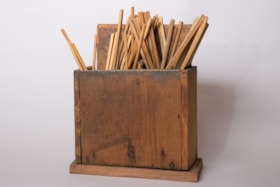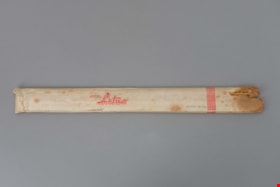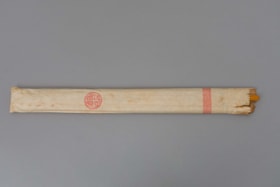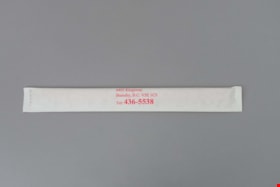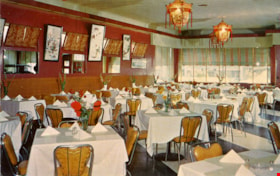Narrow Results By
box
https://search.heritageburnaby.ca/link/museumartifact24471
- Repository
- Burnaby Village Museum
- Accession Code
- HV975.5.966
- Description
- Brown wooden box, rectangular with higher back. There are two sections holding chopsticks.
- Object History
- This item originates from the Chinese Herbalist Store "Way Sang Yuen Wat Kee & Co.", Victoria, B.C. Chopsticks are used for stirring materia medica while they are boiling in the pot to prevent them from sticking at the bottom of the pot and getting burnt. They might also have been used for paozhi (processing of materia medica) since it may involves boiling, steaming, roasting, frying and / or calcifying.
- Classification
- Chemical T&E
- Measurements
- 30 cm H x 20 cm W x 5cmL
Images
chopstick
https://search.heritageburnaby.ca/link/museumartifact39973
- Repository
- Burnaby Village Museum
- Accession Code
- BV999.28.12
- Description
- Chopsticks, wooden; four; with paper bag, white with red "Hotel Lotus" and figures, and border
- Object History
- Donor inherited object from her mother and grandmother, ca. 1994. The Hotel Lotus was located in Vancouver at the corner of Pender and Abbott Streets. There was a restaurant located there in the 1950's & 60's called "Lotus Gardens" that featured Chinese and Western cuisine.
- Category
- 04.Tools & Equipment for Materials
- Classification
- Food Service T&E - - Eating & Drinking Utensils
- Object Term
- Chopsticks
- Subjects
- Persons - Chinese Canadians
Images
chopsticks
https://search.heritageburnaby.ca/link/museumartifact45241
- Repository
- Burnaby Village Museum
- Accession Code
- BV003.2.1
- Description
- Pair of wooden chopsticks in white paper package, from the "GRAND BUFFET RESTAURANT", 6041 Kingsway, Burnaby, B.C., V5E 1C5; "Tel: 436-5538"; all lettering in red, and Chinese characters in blue and red.
- Category
- 04.Tools & Equipment for Materials
- Classification
- Food Service T&E - - Eating & Drinking Utensils
- Object Term
- Chopsticks
- Subjects
- Persons - Chinese Canadians
- Historic Neighbourhood
- Edmonds (Historic Neighbourhood)
- Planning Study Area
- Windsor Area
Images
History of Burnaby Resource Guide
https://search.heritageburnaby.ca/link/museumlibrary7492
- Repository
- Burnaby Village Museum
- Author
- Burnaby Village Museum
- Publication Date
- 2019
Canadian
restaurant that opened in September
1950. The community staple was
known for its neon dragon sign that
advertised “Chop Suey”. One side of
the kitchen served Chinese foods,
while another served Canadian dishes.
Chinese cuisine such as rice would be
served with chopsticks, while steaks
- Repository
- Burnaby Village Museum
- Collection
- Digital Reference Collection
- Material Type
- Digital Resource
- Accession Code
- BV019.63.1
- Author
- Burnaby Village Museum
- Place of Publication
- Burnaby, BC
- Publisher
- City of Burnaby
- Publication Date
- 2019
- Physical Description
- 21 p. : ill.
- Library Subject (LOC)
- Burnaby (B.C.)--History
- Directories
- Object History
- Created from research gathered by Burnaby Village Museum staff into the diverse History of Burnaby.
Images
Digital Books
Interview with Jiro Kamiya, 2015
https://search.heritageburnaby.ca/link/museumdescription4476
- Repository
- Burnaby Village Museum
- Date
- [2015]
- Collection/Fonds
- Burnaby Village Museum fonds
- Description Level
- Item
- Physical Description
- 1 sound recording (mp3) (01:11:02 min)
- Scope and Content
- Recording of a interview with Jiro Kamiya about the ofuro he built as an exhibit for display at Burnaby Village Museum, and his work in Canada generally. When he speaks in Japanese, his son Frank Kamiya does the English translation. Frank recalls how his father, a Japanese-trained carpenter, came …
- Repository
- Burnaby Village Museum
- Collection/Fonds
- Burnaby Village Museum fonds
- Series
- Museum Oral Histories series
- Subseries
- Museum research interviews subseries
- Description Level
- Item
- Physical Description
- 1 sound recording (mp3) (01:11:02 min)
- Material Details
- Interviewer: Lisa Codd Interviewees: Jiro Kamiya and his son Frank Kamiya Location of Interview: Nikkei Home, Burnaby Interview Date: [2015] Total Number of Tracks: 1 Total Length of all Tracks: 1:11:02
- Scope and Content
- Recording of a interview with Jiro Kamiya about the ofuro he built as an exhibit for display at Burnaby Village Museum, and his work in Canada generally. When he speaks in Japanese, his son Frank Kamiya does the English translation. Frank recalls how his father, a Japanese-trained carpenter, came to be involved in the project, which was donated to the Museum by the Japanese Canadian Citizens Association. An unidentified woman is also present and contributes to the discussion. 0:00 – 6:38: Frank Kamiya recalls the museum’s ofuro project, describing how his father became involved with it. He talks about the ofuro in Canada, speaking of their importance to Japanese Canadians but noting that they have been superseded by newer products. Frank also mentions that ofuros are now subject to modern building regulations. 6:38 – 20:30: Jiro Kamiya describes the construction of the ofuro. He explains the technique of water-proofing and talks about the different sizes of baths, discussing the differences in Japanese and Canadian styles and in the way water was supplied. 20:30 – 28:27: This portion of the recording pertains to Jiro Kamiya’s background as a carpenter in Shizuoka, Japan, in the family’s business, and how he came to immigrate to Canada. Frank talks about his father’s innovations and skills. He discusses the differences between Japanese and Canadian tools. Lisa Codd asks about the tools Jiro donated to the museum. 28:27 – 36:00: Frank talks about his father’s involvement in the building of the Museum’s ofuro. He notes that he himself drew up the plans and submitted them to City Hall. He asks about the ofuro’s plaque and the building’s condition. Lisa explains how the classification of buildings as replica or heritage determines how conservation choices are made. 36:00 – 45:47: Frank describes the purpose and use of the ofuro and the kind of accessories which should be included in the Museum’s display. The exact meaning of ‘ofuro’ is discussed with Jiro, as is bathing protocol for the larger and smaller kinds. 45:47 – 59:13: Jiro recalls New Year and other traditions and Lisa and Frank remark on the differences between the established infrastructures of Japan and those of rural Canada. Frank describes his father’s work in Canada. Jiro talks of being unable to join the carpenters union, but advancing in his profession through his ability and experience with Japanese techniques. 59:13 – 1:11:02: Jiro talks about the work that he did during internment during World War II and his choice to go to Winnipeg with his family. Frank relates how his father adapted to shipyard work, and Jiro tells anecdotes about his working years.
- History
- Interviewee: Jiro Kamiya (ne Tsuneki) was born on August 29, 1910 in Shizuoka Ken, Japan to parents Torakichi Tsuneki and Sono Ssuneki. In 1936, Jiro married Toneko Kamiya. The Tsuneki family were Master Carpenters for over 500 years and the family business, Torakichi Tsuneki Construction Co was the largest and best known construction company in Shizuoka Ken. Jiro also became a master carpenter working for his father's company. In 1933, Jiro immigrated to Canada and in 1936, he returned to Japan to marry. In 1937 he got work at the Hammond Cedar Mill leading a crew of six men and worked there for about three or four years. In 1942 along with over 21,000 Japanese Canadians, Jiro and his family were forcibly removed from the coastal area of British Columbia. Jiro and his family were relocated to Oak Bluff, Manitoba to work on the beet farms. JIro chose this location of internment so that he could keep his family together. While living in Manitoba, Jiro also found work as a carpenter. In 1948 when he was permitted to return to British Columbia, Jiro and his family relocated to Kamloops. In 1951, he began working as a carpenter for Matsumoto Shipyard in North Vancouver and between 1961 and 1974, he worked for Grimwood Construction. From 1975, he worked for Dawson Hall Construction until his retirement at the age of 68. Following his retirement he built a house for his nephew on Mayne Island and a summer house for himself which he completed in 1988. In 2001, Jiro and his wife, Toneko moved to Nikkei Home. While living at Nikkei Home, Jiro made chopsticks out of hardwood, creating over a thousand pairs up until he was 99 years old. Jiro passed away in 2015. Interviewer: Lisa Codd has worked in the museum sector since 2000 and between 2005 and 2019, she worked as the curator at the Burnaby Village Museum. In 2019, Lisa began her work as the City of Burnaby Heritage Planner.
- Creator
- Burnaby Village Museum
- Subjects
- Persons - Japanese Canadians
- Names
- Kamiya, Jiro
- Kamiya, Frank
- Accession Code
- BV019.13.1
- Access Restriction
- No restrictions
- Reproduction Restriction
- No known restrictions
- Date
- [2015]
- Media Type
- Sound Recording
- Notes
- Audio is only available to listen at the Burnaby Village Museum
Audio Tracks
Interview with Jiro Kamiya, 2015, [2015]
Interview with Jiro Kamiya, 2015, [2015]
https://search.heritageburnaby.ca/media/hpo/_Data/_BVM_Sound_Recordings/Oral_Histories/2019_0013_0001_001.mp3postcard
https://search.heritageburnaby.ca/link/museumartifact90986
- Repository
- Burnaby Village Museum
- Accession Code
- BV021.12.1
- Description
- Postcard: horizontal glossy colour postcard of Golden Dragon Resturant. Shows image of interior dining room with red and gold walls, laterns, tables with white table cloths. yellow chairs and a stripped black and white floor. On reservse in blue print: , "GOLDEN DRAGON" "3991 KINGSWAY" "BURNABY, B.C." "Phone: DExter 5100" "If you are not familiar with Chinese Foods let our Experts make suggestions and explain the traditions of eating that is famous throughout the world."; at bottom, "DINE and DANCE Every FRIDAY & SATURDAY"; line down centre; at right,"POST CARD" "ADDRESS"; at upper right, "STAMP"; unused; ca.1950s
- Object History
- Postcard from the Golden Dragon Resturant which served Chinese-Canadian food. Their grand opening was September 2, 1950. The community staple was known for its neon dragon sign that advertised “Chop Suey”. One side of the kitchen served Chinese foods, while another served Canadian dishes. Chinese cuisine such as rice would be served with chopsticks, while steaks, a more western dish, would be served with knife and fork. Advertisements from the resturant and meeting notices were found in local newspapers from 1950 to 1957. The establishment was not listed in the 1966 Great Vancouver Cross-Cross Directory.
- Classification
- Written Communication T&E - - Writing Media
- Object Term
- Postcard
- Marks/Labels
- Made in Canada by Grant-Mann Lithographers LTD. "Color Card" Division, Vancouver, British Columbia.
- Measurements
- 14cm wide x 9cm high
- Subjects
- Souvenirs
- Persons - Chinese Canadians
- Food Service Tools and Equipment
- Documentary Artifacts - Postcards
- Buildings - Commercial - Restaurants
- Historic Neighbourhood
- Central Park (Historic Neighbourhood)
- Planning Study Area
- Garden Village Area
